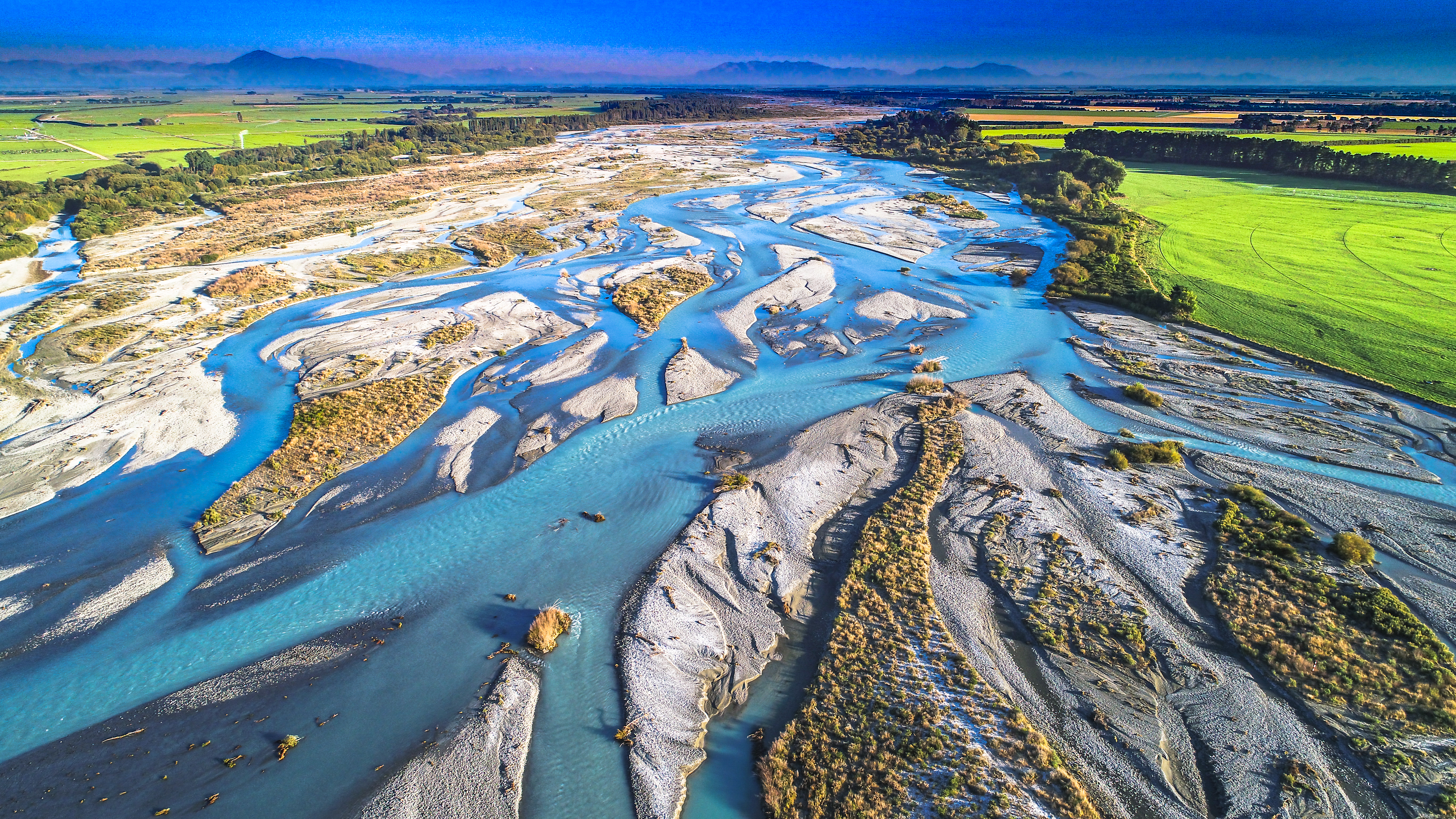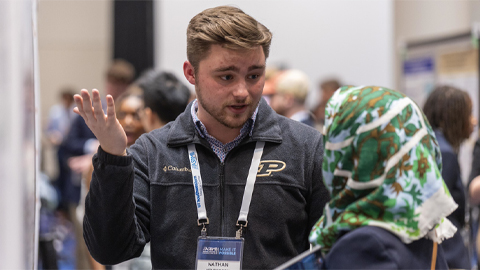Reimagining STEM workforce development as a braided river
Career prospects for trainees in science, technology, engineering, and mathematics (STEM) are growing, but today’s opportunities look less and less like the traditional science careers of the past. Individuals move in and out of roles and positions in which they consult, start businesses, and hold jobs across disciplines and sectors. People take many paths through school and weave careers around an assortment of circumstances such as rearing families, serving in the military or volunteer corps, fulfilling caregiving responsibilities, or reengaging with formal education. These experiences bring new ideas that are more creative, practical, and interdisciplinary solutions to science.

The traditional “pipeline” model of workforce development—whereby an individual follows a fairly linear, predictable, and structured path through K–12, undergraduate, and graduate education into career-length government or academic positions—no longer captures the reality of a modern STEM career. Nor does it represent the broad range of interdisciplinary and innovative opportunities that STEM professions now offer across a wide range of industries, nonprofits, and other organizations. The pipeline model has also contributed to the historical exclusion of individuals from minoritized ethnic, racial, sexual and gender identity, disability, and service status communities [e.g., Bernard and Cooperdock, 2018].
It is time for us to dismantle the pipeline. Instead, let’s take inspiration from the natural world we study and envision a new model that captures the opportunity, variability, and responsiveness of a modern STEM career; that embraces the diversity and experiences of the people who engage in it; that recognizes the many on-ramps, pathways, and career pivots that real life induces; and that provides a framework in which there is a place in STEM for everyone. This is the braided river model.
A new analogy for a modern career path
A braided river is a wide, shallow system comprising numerous interwoven and changeable channels separated by small islands. Braided rivers usually originate in steep, mountainous regions and contain varying amounts of water and river substrate, with the riverbed constantly changing and adapting to flow and sediment load. The water’s movement shapes landscapes, transports nutrients, and supports life. The braided river provides an ideal analogy for inclusive, responsive, and modern career development.

Using the braided river as a model for STEM, and specifically for geoscience workforce career development, challenges us to think holistically about learning ecosystems, as illustrated in Figure 1. This model allows us to perceive varied pathways into and within STEM careers and to better appreciate unusual entry points, evolving occupational goals, and opportunities for lifelong continuing education. In this way we normalize the idea of individuals changing pace and direction as circumstances and opportunities arise, and we can create support structures that accommodate and empower people to stay in the field. The model allows us to recognize that barriers present different degrees of challenges for each person, and in response we can create flexible and adaptable solutions and assign real value to the skills, tenacity, and insights brought to our science when these challenges are overcome.
Fostering a system in which many paths can meet and diverge requires us to envision scientific knowledge and training as part of an ecosystem. Rather than the solitary path down a pipeline, we acknowledge that STEM work benefits from partnerships with nonscientific experts and industries, policymakers, and communities, which together help us to understand and address the changes in our physical and human landscape—and to elevate the value of STEM skills across a wide range of professions.
By intentionally working to structure professional and career development to embrace the wide, varied, and inclusive pathways that careers in STEM offer, we create a more inclusive and supportive environment. Scientists from all backgrounds and identities can thrive in an environment that values their contributions, works with rather than against their lived experiences, and is responsive to future opportunities.
How might the braided river model look in practice? At each stage of development, we draw from the now extensive knowledge of diversity and inclusion in STEM [e.g., National Academies of Sciences, Engineering, and Medicine, 2011, 2016, 2019, 2020]. We consider not just whom to reach and where they might enter the field, but how we are making sure that each individual is engaged and supported along their journey.
Accommodate many water sources
A pipeline has one main entry point. If you miss that entry, you might be left out of the pipe permanently, or, if you’re fortunate or ambitious enough, you might be able to painstakingly plumb in your own entry point and hope no one closes the valve. The braided river model eliminates the need for formal infrastructure, allowing people to flow from multiple points into a STEM career.
While we strive to inspire and encourage students to pursue an interest in the geosciences throughout their precollege schooling, we know that opportunities to engage in the geosciences in school are highly variable and often not equitable. Fostering robust partnerships with community organizations that can engage young minds with Earth science topics through informal learning, especially in disadvantaged communities, and working with teachers to bring geoscience content to their classrooms can gently direct more potential scientists to a river they might otherwise not have known existed.
For students who make their way to college, many discover through electives that their love for the geosciences offers a career path—a so-called “discovery major.” Yet few community colleges and minority-serving institutions offer geoscience classes, so many students don’t discover the discipline at all. Let’s expand opportunities for the discovery of this exciting discipline that can lead to a rewarding profession to more students. Colleges and universities can work with local schools to raise awareness of geoscience careers. Partnerships between community colleges and research-intensive universities can help build bridges through aligned prerequisites, transfer support, and extracurricular opportunities. Research internships, such as those offered by the Research Experiences for Undergraduates (REU) program, offer learners the opportunity to apply their skill sets to geoscience research, while community-based participatory research programs and crowdsourced science projects can connect geoscience concepts with community needs. Apprenticeships can be developed that demonstrate how geoscience skills are used in the industry and offer students the opportunity to observe and learn from professional geoscientists, and professional organizations can develop resources that help students understand the pathways to geoscience careers.
What about people who begin in non-STEM professions or disciplines but become inspired to change career paths? We can facilitate their transition into the geosciences by recognizing and encouraging them to capitalize on the diverse skill sets they’ll bring with them. Employers should facilitate this entry by offering tailored training programs or certificates, short continuing education courses, career mentorship programs, and more inclusive recruiting that would help create easily traversable channels from one stream to another.
We must also recognize that so much geoscience knowledge lies within communities and outside of formal education institutions. The pathways of our river do not solely represent careers—they also represent the relationships we make to enrich our scientific work. We must become better at weaving our knowledge with that of Indigenous and local communities who have historical connections with the land we study. It should be a natural part of our research to create partnerships with the communities whose lives and livelihoods are affected by the challenges we are working to solve. Similarly, we should more openly engage with industry and nongovernmental organizations that have the resources, networks, and infrastructure that could be better used to serve our planet with direct access to our scientific research.Support braided pathways
Once we’ve guided someone to one of the many entry points to a geoscience career, we must keep in mind the individualized pathways they will take throughout that career. Embracing the braided river system as a model means creating ways to support, retain, and, as necessary, reengage science professionals, whatever their route, wherever they join, and whatever the speed of their journey.A new system, however, requires systemic changes. Educational and scientific institutions need to rethink graduation, promotion, and tenure requirements to account for more varied pathways and timetables. Interdisciplinary learning tracks can lead to degrees that connect social and physical sciences, or offer supplemental education that can be pursued while working in industry or nonprofit sectors. If the scientific community wants to include large swaths of people who deal with even basic life events, employers must provide reasonable maternity leave and realistic part-time opportunities, and create clear pathways for reentry into the community, such as funding opportunities specifically for midcareer scientists who return after other life ventures.
Rather than mentoring programs directed at supporting only young scientists, we should promote mentor relationships at all career levels and stages, across disciplines and industry–academia boundaries, and even among peers. Let’s normalize the idea of having multiple mentors, sponsors, cohorts, and other professional support to reduce dependence on a single gatekeeper, diversify our knowledge of our colleagues’ experiences, and enhance our overall feeling of belonging to this rewarding professional community.
Finally, we cannot make progress in building a more flexible career model if we do not recognize and value the work of broadening participation, in practice and in reward structures, and if we do not acknowledge that mentoring, true collaboration, and community partnership take time to develop. Success in science should be measured not just in citations but also in broader positive impacts.
Dismantling the pipeline
As our climate changes and technology evolves, we need more people with exceptional science skills and the creativity that comes from diverse teams with different experience to solve the quandaries of our time. The pipeline career model no longer works to characterize the array of educational and career pathways into and within STEM, nor does it meet our need for developing a workforce that is diverse, engaged, and supported.
The braided river illustrates the larger ecosystem that scientific professions—and the institutions that support them—are a part of. We can move toward this model by working consciously to know and share the varied opportunities that a modern geoscience career encompasses; by profiling careers that serve our communities, protect our environment, and engage across all sectors; and by recognizing these contributions in our teaching and professional development offerings. Students and their families will see meaningful, well-paying jobs that expand the vision of what “being a geoscientist” might be, and we’ll recruit or retain midcareer professionals so that people from all backgrounds and identities can thrive and can best tackle the pressing challenges facing our planet.
This article is republished from Eos, Science News by AGU. Read the original here.
Enjoy reading ASBMB Today?
Become a member to receive the print edition four times a year and the digital edition monthly.
Learn moreFeatured jobs
from the ASBMB career center
Get the latest from ASBMB Today
Enter your email address, and we’ll send you a weekly email with recent articles, interviews and more.
Latest in Opinions
Opinions highlights or most popular articles

Hope for a cure hangs on research
Amid drastic proposed cuts to biomedical research, rare disease families like Hailey Adkisson’s fight for survival and hope. Without funding, science can’t “catch up” to help the patients who need it most.

AI can be an asset, ASBMB educators say
Pedagogy experts share how they use artificial intelligence to save time, increase accessibility and prepare students for a changing world.

Sketching, scribbling and scicomm
Graduate student Ari Paiz describes how her love of science and art blend to make her an effective science communicator.

Embrace your neurodivergence and flourish in college
This guide offers practical advice on setting yourself up for success — learn how to leverage campus resources, work with professors and embrace your strengths.

Survival tools for a neurodivergent brain in academia
Working in academia is hard, and being neurodivergent makes it harder. Here are a few tools that may help, from a Ph.D. student with ADHD.

Hidden strengths of an autistic scientist
Navigating the world of scientific research as an autistic scientist comes with unique challenges —microaggressions, communication hurdles and the constant pressure to conform to social norms, postbaccalaureate student Taylor Stolberg writes.

